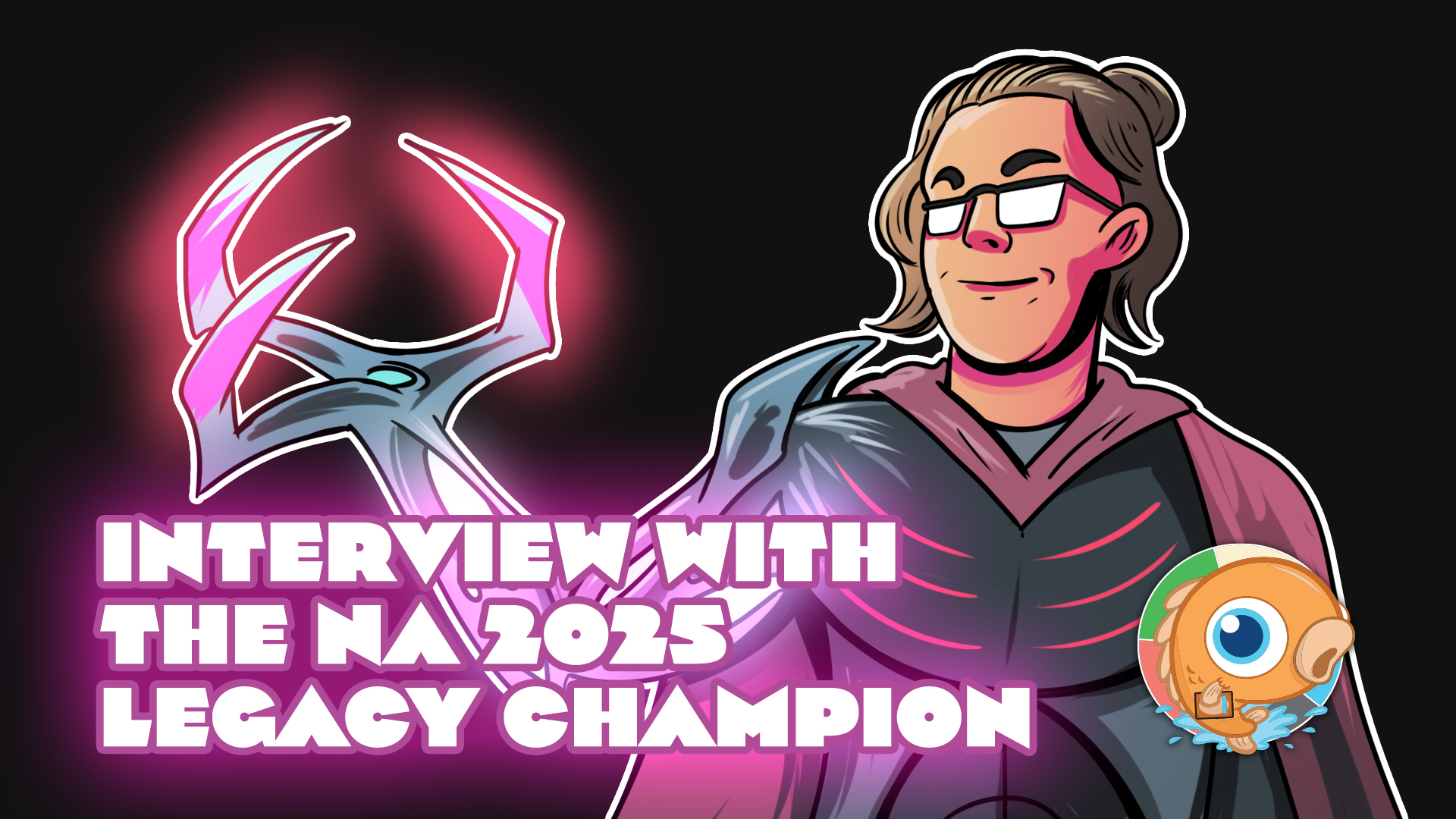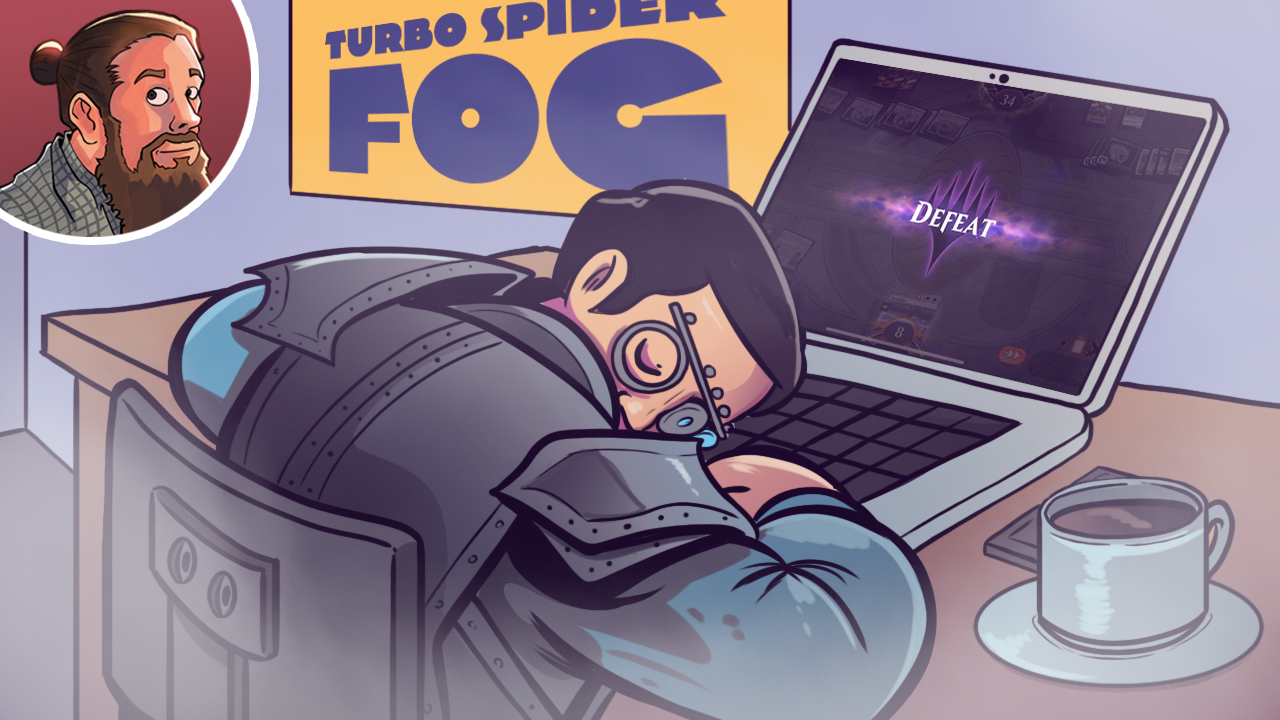Keeping up with the Kaladeshians (PAX Spoilers)
For most sets, spoilers trickle out day by day on the Mothership and other websites—one in this article, another in that article—as a result, it takes a little while for things to really heat up. However, each year, there is one exception for the fall set, which gets a massive roll out thanks to PAX. This means that, even though previews don't officially start until Monday, we not only got a ton of Kaladesh cards to talk about but all of the set's mechanics and a bunch of rares and mythics! So, today, we are going to be catching up on all the Kaladesh news from PAX and breaking down the most exciting cards previewed thus far. Let's start with one of the most hyped cards from the set: the new planeswalker Saheeli Rai!
Saheeli Rai
I should start by saying that Saheeli Rai is the exact type of card that I trash in an article that then ends up being $50 a couple of months later (see: Jace, Vryn's Prodigy), so keep that in mind as we discuss the card. So far, it seems like the reviews on Saheeli Rai have been almost universally positive, with pretty much everyone on social media declaring the card somewhere between very good and broken. At the risk of being a wet blanket, I'm not convinced. Let's start by talking about the positives, and then we'll get to the negatives.
Saheeli's Pros
The biggest reason to think that Saheeli Rai will be playable and maybe even good is that she's just three mana and three-mana planeswalkers have a sterling track record of playability. Over the game's history, there have been a total of eight planeswalkers at that converted mana cost, and the worst of the bunch is pretty clearly Ajani, Caller of the Pride, which still saw a reasonable amount of play in Standard. Domri Rade was a Standard staple, while Ashiok, Nightmare Weaver, Jace Beleren, and Nissa, Voice of Zendikar were / are Standard staples that also see play in Modern. Liliana, the Last Hope is currently the ninth-most-played spell in Standard, Dack Fayden is a Vintage staple, and Liliana of the Veil is a multi-format all-star. Literally every single three-mana planeswalker has been at least good, and a reasonable number have been great. As such, based on the history of three-mana planeswalkers, it seems fairly safe to say that if Saheeli Rai is anything less than very good in Standard, she would be an outlier rather than the norm.
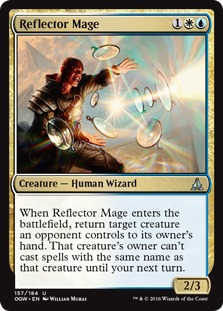


The second positive of Saheeli Rai is that her ˗2 ability allows you to reuse enters-the-battlefield triggers. That means in Standard, you can copy a Reflector Mage and bounce another creature or a Goblin Dark-Dwellers to flash back another spell. In Modern, Saheeli Rai can be Snapcaster Mages five through eight or hasty Primeval Titan to get some more lands. I'm not sure whether this is enough to make Saheeli Rai playable—unfortunately, you can only ˗2 her once before having to take a turn off to +1, since she only starts with three loyalty—but in the right build, the minus ability could be very powerful.
Saheeli's Cons
On the other hand, Saheeli Rai is extremely bad at protecting herself. Actually, she doesn't protect herself at all. End of story. That said, this isn't all that uncommon for three-mana planeswalkers, with Ajani, Caller of the Pride, Ashiok, Nightmare Weaver, and Jace Beleren also failing to put up any immediate defense. What is a bit troubling is that all of the other three-mana planeswalkers that don't play defense come into play with five loyalty, assuming you immediately use their plus ability, while Saheeli Rai only comes into play with four. As a result, not only is Saheeli Rai bad on defense, but she's also the most fragile three-mana planeswalker, which is a pretty scary combination.
The other big problem I have with Saheeli Rai is that she doesn't really do anything on her own when she enters the battlefield. Her +1 ability might be the weakest of all of the three-mana planeswalkers. One damage just isn't that much, and scry 1 isn't all that impressive either in many matchups. While scrying every turn is great in control matchups, I'm unsure if those matchups will be common enough to make Saheeli Rai's +1 ability good. Of course, we don't really know what Standard will look like a month from now when Kaladesh enters the format, so perhaps things will look better for Saheeli Rai post-rotation.

Finally, if you look at the most popular UR deck in the format—the UR Spells deck featuring Thermo-Alchemist—there's a very real argument that Fevered Visions is simply better at the same mana cost. I mean, Saheeli Rai is deal one damage and draw 0.6 cards a turn, while Fevered Visions is usually two damage and draw an entire card each turn (although, to be fair, it also generates card advantage for your opponent). More importantly, being in two colors is a fairly real downside. Liliana, the Last Hope can go into mono black, GB Delirium, WB Contol, Jund, and a whole bunch of other decks. Saheeli Rai, on the other hand, is pretty much limited to UR or possibly Jeskai or Temur, if tri-color decks emerge in Standard.
As such, I'm simply not that excited about Saheeli Rai, especially in Standard. While I expect that she will see some play in specific decks (especially decks that can abuse her ˗2 ability), this isn't a format-defining card. It's a fun card, and it can do cool things in multiplayer—where the +1 ability is more powerful—and might be fringe playable in older formats (where it can copy Snapcaster Mage or pitch to Force of Will), but it's just too fragile and color intensive to be a dominant force in Standard. Of course, now that I've explained why I don't think Saheeli Rai is that good, odds are she will be all over Pro Tour Eldritch Moon a month from now and end up spiking to $50.
Mechanic: Energy

In all honesty, it's pretty premature to talk about the biggest news to come out of Kaladesh: a brand new resource system that goes by the name "energy." Maybe the easiest way to think of energy is as another type of mana, except it doesn't empty from mana pools at the end of turns or phases (it is also stored as counters, for proliferate synergy). Take Aetherworks Marvel, for example. When it's on the battlefield, you get an energy counter every time a permanent goes into your graveyard, and once you store up six energy, you can use it to activate Aetherworks Marvel or spend it on anything else that has an energy cost.
While the addition of a new resource system to the game is huge news, at this point, we just don't know what we'll be able to do with it. Will energy literally compete with mana and be used to cast creatures and spells, or will it just be used to activate abilities on permanents? How will we actually make energy? Will there be lands that tap to add one energy? An energy Dark Ritual? Energy mana rocks? At this point, we simply don't know. It's possible that energy could be completely broken, assuming it gets enough support, or it could be relatively unplayable. We'll just have to wait and see.
So far, we have seen a total of three energy cards (editor's note: a couple more commons have been revealed, and while we don't have an energy Black Lotus, it does look like the mechanic is getting quite a bit of support, although how playable the support cards are remains to be seen): Aetherstorm Roc, which adds an energy whenever a creature enters the battlefield under your control; Architect of the Untamed, which triggers whenever a land enters the battlefield under your control; and Aetherworks Marvel, which triggers when things go to your graveyard. While it seems possible to generate a lot of energy with these cards—for example, by using token generators with Aetherstorm Roc on the battlefield or resolving a Splendid Reclamation with an Architect of the Untamed out—the bigger issue is that both of these cards feel underpowered without energy, which brings us back to the same question: just how much support will energy get in Kaladesh?
Because it's completely new and different, one of the major downsides of the mechanic is that energy doesn't really work with anything else in Standard (or any other format, for that matter). Yes, Splendid Reclamation can help Architect of the Untamed generate energy, but unlike most mechanics, if an energy-themed deck is going to show up, it's going to have to draw almost exclusively from Kaladesh. While we have seen mechanics with only one set of support make a splash before (devotion), far more often, we see one-set themes and mechanics come up short until they get more support (Allies). As such, it probably makes the most sense to look for powerful standalone energy cards or specific synergies rather than betting on an energy theme deck showing up in September, at least until Aether Revolt releases this winter.
Speaking of standalone cards featuring the energy mechanic, Aetherworks Marvel looks to be one of the strongest, although I'm not sure it can be completely self-contained, since waiting for six cards to go to your graveyard would make it incredibly slow without additional support. As a result, evaluating Aetherworks Marvel has a lot of the same problems as evaluating energy as a whole: we just don't know how easy it will be to produce energy. Discounting support cards, which could make Aetherworks Marvel much better, let's imagine it's the only card in the set with the mechanic (which, of course, it is not). Is Aetherworks Marvel playable on its own? Probably not, outside of specific combo decks (for example, playing sacrifice outlets and then trying to cast an Emrakul or Griselbrand on Turn 4. For example, in Modern, you could use Shimatsu the Bloodcloaked or Mana Seism to sacrifice all of your lands, turn them into energy, and use Aetherworks Marvel to cast an Emrakul, the Aeons Torn on Turn 5. It also works well with cards like Chromantic Sphere and Chromantic Star, which are cheap ways to cycle through your deck while also generating energy counters.
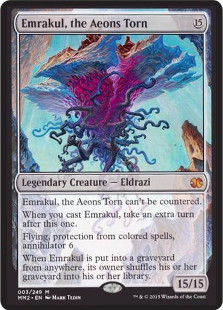


The good news is that the ability is quite strong, and if there is enough ways to repeatedly produce a lot of energy, Aetherworks Marvel could be quite good. It's almost like a repeatable Collected Company with the downside of only hitting one thing but the upside that all restrictions are gone, so you can not only cheat massive creatures into play but also cast spells, enchantments, or even planeswalkers, so it should be close to impossible to whiff. It's also worth mentioning that Aetherworks Marvel actually allows you to cast the card, so you'll get any enters-the-battlefield or "when cast" triggers, which means you get to steal a turn with Emrakul, the Promised End, exile stuff with Ulamog, the Ceaseless Hunger, or tap an opponent down with Elder Deep-Fiend, which could make the card good enough in Standard.
All in all, probably the best thing to do is wait and see what support emerges for the energy mechanic. As of right now, it seems like the ceiling is extremely high and the mechanic could even be broken, but the floor is also extremely low, because energy doesn't get any help from the other 16,000 Magic cards in existence. It could end up being the next storm, or it could end up being the next banding. We'll have to wait for more previews roll out over the next couple of weeks to really get a feel for the mechanic's potential.
Mechanic: Vehicles



Kaladesh might be the hardest set to evaluate in years. Typically, a lot of new mechanics are similar to older mechanics, like putting counters on something, being some variation of kicker, and so forth, but for Kaladesh, both energy and vehicles are not only new but exciting and extremely unique. Finding a good comparison for a vehicle like Skysovereign, Consul Flagship is actually pretty challenging. In some ways, they are like Rusted Relic, being artifacts that are only sometimes creatures, although tapping X power worth of creatures is likely much easier than having metalcraft. They are also somewhat like the God cycle from Theros, although again, there's a huge difference between tapping a creature or two and getting seven mana symbols on the battlefield.
First off, the flavor of vehicles is off the chart. These are massive, powerful machines, but they don't do anything without someone to pilot them, so in that sense, vehicles are a huge win. As far as playability, I have a couple of big questions. Most importantly, we are trained that cards that need other cards to be good usually are bad, at least for competitive play, and not only do vehicles need other cards (creatures) to be good, but most don't do anything at all without support. As such, the payoff really needs to be worthwhile to make up for the risk and inconsistency that comes with playing these types of cards. Second, just how many vehicles can you play in a deck? Here, I expect that the number is fairly low, since they simply don't stack very well. Most decks in Standard should be able to consistently activate a vehicle, but getting car-flooded is a very real problem, since once you get two or three vehicles on the battlefield, it's going to be extremely difficult to find enough pilots to keep them all running consistently.
Thats said, there may be some ways around the pilot problem, especially for rare vehicles. I mean, a 5/3 with trample and haste for four mana is fairly likely to sacrifice itself during the end step anyway, so maybe just getting in one attack with Fleetwheel Cruiser with its "enters the battlefield" trigger is good enough. After hitting for five, you can just leave it parked until you happen to draw a creature and then take it out for another spin. Speaking of pilots, one of the big upsides to vehicles is they give you a way to take advantage of summoning sick creatures: while they might not be able to tap, attack, or block, they can take a drive, so having something like Fleetwheel Cruiser or Ovalchase Dragster sitting around means any random creature you happen to draw comes with the kicker of a huge, tramping attacker.
Speaking of driving, Skysovereign, Consul Flagship itself looks to be extremely powerful, considering it's colorless and can go in any deck. Giving a mono-blue or mono-green deck access to a repeatable Fiery Impulse is somewhat surprising. The enters-the-battlefield trigger is one of the big allures of the card. Most vehicles don't do anything if your board is empty, but Skysovereign, Consul Flagship is, at its very worst, a removal spell—a horrible removal spell but a removal spell nonetheless—while you are waiting to find a pilot.
In many ways, Skysovereign, Consul Flagship seems to line up pretty well with our current Standard format (again, we don't know much of Kaladesh, so this analysis is premature at this point). At five mana, it dodges Spell Queller, and all of the vehicles naturally dodge Reflector Mage (and all sorcery-speed removal, for that matter), since you don't have to activate them during your opponent's turn unless you really want to. Better yet, three damage actually kills a lot of important creatures, including not just Reflector Mage and Spell Queller but also Sylvan Advocate (most of the time), Duskwatch Recruiter, Thalia, Heretic Cathar, and most other playable early-game creatures. In the late game, you can use the trigger to shoot down Thopter tokens, which could keep Skysovereign, Consul Flagship from getting in combat damage.
The downside is that an opponent doesn't really need to kill your hulking Skysovereign, Consul Flagship to keep it under control; instead, they can just focus on killing your other creatures to keep your vehicle in neutral. Having to tap creatures to turn on Skysovereign, Consul Flagship is also a bit scary because it leave youvulnerable to getting hit on the backswing, since you'll be down some number of blockers. Also, having crew 3 is a bit annoying. While the other other vehicles we've seen so far have crew 1 or crew 2, which means that just about any single creature you draw off the top will allow them to activate, there's a very real possibility that with Skysovereign, Consul Flagship, you'll have a creature on the battlefield but that creature alone will not be good enough to drive it, which could lead to some awkwardness.


The big question is whether vehicles are going to be constructed worthy. Cards that need other cards to be good are often a trap. I mean, would you rather have an Archangel Avacyn that is always a 4/4 that can attack and block or a Skysovereign, Consul Flagship that will sometimes just be an extremely overcosted Fiery Impulse? In some ways, this is a trick question because Skysovereign, Consul Flagship is colorless and can theoretically go in any deck (well, most decks). All in all, I think it will see play and likely be very good, but it feels like a one- or two-of rather than the second coming of Archangel Avacyn or Dragonlord Ojutai.
As for the most aggressive Ball Lightning vehicles, I could see them as curve toppers in aggressive builds, but without actually playing the cards, I have a hard time imagining running more than one playset of vehicles in total before draws start to get clunky—you just don't need that many cars. Maybe the easiest way to think about Fleetwheel Cruiser and Ovalchase Dragster is as really weird equipment. In the early game, you get damage in with your Falkenrath Gorger or Thraben Inspector; then, in the midgame, when your one-drops are likely outclassed, you can upgrade your relatively useless creature by tapping it to pilot a vehicle. As such, I expect that we will see vehicles in Standard. Skysovereign, Consul Flagship seems quite strong outside of the expensive crew cost, and the rest are exciting because they are colorless and can go in any deck, but I wouldn't expect to see more than a few in the same deck.
Inventors' Fair
While it might not be obvious at a quick glance, Inventors' Fair is a very strong Magic card. Tutoring is a strong, often tournament-worthy ability, and tutoring on a land is especially powerful because the opportunity cost is incredibly low; instead of taking up a taking up a non-land slot in your deck, the downsides are that you have to play enough artifacts to activate it and you have a land that taps for colorless mana (not a huge deal, especially in a deck that's playing enough artifacts to activate it). If you have any doubts about the card's power level, consider that the best artifact tutor in Modern is Fabricate, which only costs one less mana than Inventors' Fair, takes up a non-land slot in your deck, and forces you to play blue mana. Or, consider the fact that lands that can tutor, although scarce, are almost always playable and sometimes even broken. Eye of Ugin is banned in Modern, Sanctum of Ugin is close to a Standard staple and playable in Modern, and Tolaria West was one of the most important cards in Bloom Titan before the deck got banned. While perhaps not as good as Eye of Ugin, since Eye of Ugin is repeatable, it seems likely that Inventors' Fair is on par with, and maybe even better than, Sanctum of Ugin (which has a pretty heavy deck building restriction of its own) and Tolaria West (which can only tutor for other lands or zero-mana cards like Summoner's Pact).
As such, I have very little doubt that, given the right deck, Inventors' Fair has enough power to be playable in Standard, Modern, and possibly even Legacy. The only question about Inventors' Fair is if the right deck exists. In Standard, it's pretty much a crap shoot at this point, since most of the artifacts in the format will come from Kaladesh and we haven't seen very much of the set. While I expect that the artifact theme will be pushed enough that some decks will want Inventors' Fair—if not this fall, then at least after Aether Revolt hits the format this winter—at this point, it's premature to even speculate about what that deck might look like. It's also worth noting that randomly gaining a life each turn is pretty strong. We've seen cards like Nyx-Fleece Ram see play in the not-too-distant past, so even without great tutor targets, midrange and control decks that can regularly achieve metalcraft will likely play a copy of Inventors' Fair for this reason alone.




In Modern, there are a few possibilities. While Affinity might seems like a logical choice, since it's the most popular artifact-based deck in the format, I have a feeling that Inventors' Fair might simply be too slow for the deck. That said, it could potentially be a one-of to search up an Etched Champion or Cranial Plating. More likely landing spots are probably fringe decks like Lantern Control, which typically has a bunch of artifacts sitting on the battlefield and usually doesn't has much to spend its mana on in the mid-game, where Inventors' Fair could be a way to search up a life-saving Ensnaring Bridge, a Welding Jar for protection, or a Sun Droplet out of the sideboard. It's also worth noting that Inventors' Fair can find both halves of the Sword of the Meek / Thopter Foundry combo.
However, maybe the best place for Inventors' Fair is some sort of Eggs build. Current builds of Eggs are extremely dependent on finding a copy of Krark-Clan Ironworks to generate enough mana to combo off, and the deck always has a ton of artifacts sitting on the battlefield, so Inventors' Fair could add some consistency. Even better, Eggs uses Faith's Reward to get artifacts and lands back from the graveyard, so after you search up Krark-Clan Ironworks for mana, you can get back Inventors' Fair and use the mana to tutor up something else—either a one-of finisher or powerful sideboard options like Defense Grid, Torpor Orb, or Tormod's Crypt—to help protect the combo.
Financially, being legendary will likely hold down the price, since it will be hard to play more than one or two. Plus, unless a colorless land can see play across archetypes (like Westvale Abbey or Mutavault), it likely won't be all that valuable (see: Sanctum of Ugin), even if it manages to be a four-of in a specific deck. As such, I'd wait to pick up copies. I expect we'll see prices drop down below $2 over the next couple months, despite the power level of the card.
Enemy Fastlands
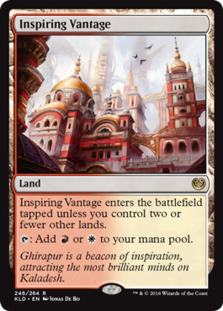


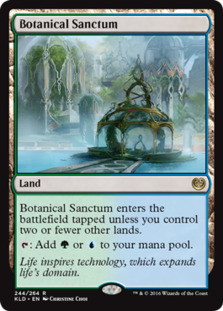

After endless debate and speculation over what land cycle would show up in Kaladesh, we now know that it's the completion of the fastland cycle originally printed in Scars of Mirrodin. While this cycle isn't quite on the level of fetchlands or shocklands, there's a very strong argument that the fastlands are the third best cycle of lands in Modern, so getting the enemy members of the group is huge, huge news.
As far as Standard is concerned, the fastlands will replace the rotating enemy painlands, and for the most part they will play pretty much the same, with the fastlands generally being an upgrade since they don't cost life. Having access to fastlands will mean aggressive decks will still have a cycle of dual lands that will come into play untapped early in the game, just as the painlands did, and as far as control is concerned, having some more tapped lands in the mid and late game might be a fine trade off for not paying life for colored mana. So in one sense, nothing really changes in Standard; fastlands are simply an upgrade to painlands and decks will just immediately swap one for another. However, there is one massive exception.



With painlands in the format, playing Eldrazi was essentially a free roll—you could be a Bant deck with running eight painlands and feel perfectly comfortable playing Eldrazi Displacer—but now this all changes. No longer will UR decks be able to play Shivan Reef and some off-color painlands (for instance, Yavimaya Coast as a blue and colorless dual land) and be an Eldrazi deck. If you want to cast Thought-Knot Seer or Reality Smasher, you're going to have to pay a very real cost by running true colorless lands. Does this means that Eldrazi are dead and will disappear from the format? No, not necessarily. We've seen completely colorless Eldrazi decks floating around and having some amount of success. It does means that it will be much harder to be a "normal" deck with Thought-Knot Seer and Reality Smasher in your sideboard, or to be a three (and possibly even two) color Eldrazi deck. Moving forward, I'd except to see more Mono-Red Eldrazi, Mono-White Eldrazi, and Mono-Blue Eldrazi, assuming that players find that the payoff is still good enough in the new Standard format. Moving on from Standard, the biggest impact of the enemy fastlands will likely be in Modern.



One of the reasons fastlands are so powerful in Modern is that they do one thing better than any other land cycle in the format: give you access to two different colors of mana on turn one, for free. Say that you're a deck like GU Infect, a decent amount of the time you're going to want green mana on turn one to cast a Noble Hierarch or Glistener Elf, however you're also going to want the option of casting a Serum Visions. You can do this with Breeding Pool, but it will cost you two life (and three if you fetch it out). Having some number of fastlands gives you a way to access both colors of mana, for free, on turn one (and again on turn two and three).
And this is what we've seen from the allied fastlands, which have been in the format for a while. They don't replace fetches and shocks, at least to any great degree, but a lot of decks are likely to run some number (the average is about three for most fastlands) in support of the fetch and shock manabase. In fact, every single member of the fastland cycle shows up among the top 50 lands in Modern, right alongside the shocks and fetches. Aggressive decks like them since the provide untapped mana, and control decks like them since they are pain free, which can be important in a world of Burn and Zoo. When you really think about the format, there are quite a few decks that don't really want to get past three or four lands anyway, so coming in tapped as the fourth, fifth or sixth land isn't really that much of a downside. All this to say, we should be expecting to see a lot of the enemy half of the cycle, not just in Standard, but in Modern as well.
Financially, it seems likely that most of the fastlands will end up in the $4 range by this winter, although they will have potential to increase at various rotations, depending on what the format looks like. Last time around, Darkslick Shores and Seachrome Coast ended up extremely expensive. Even at their most expensive, I wouldn't expect much more than $6 to $8, and even that might be a stretch. Basically, think of these like the painlands, but with only one printing and more Modern demand—if the painlands, with multiple printings can hang around $4, these should have no problem doing the same.
Other Stuff

Rashmi, Eternities Crafter is an odd hybrid of of Shardless Agent and Momir Vig, Simic Visionary. Over the course of a long game, the amount of value she can generate is pretty insane—in the worst case, she is drawing you an extra card every turn she lives; in the best case, she is letting you cheat on mana by casting some powerful stuff for free. As far as Standard is concerned, I'm a little bit worried about the fact that she doesn't do anything right away. Four-mana threats that need to untap to generate value aren't especially exciting in a world of Spell Queller and Reflector Mage, and while Collected Company will rotate, it seems likely that both of those cards will remain major parts of Kaladesh Standard. Another comparison is Master Biomancer—another four-mana Simic mythic that's clearly powerful but never really found a home. I'm leaning towards Rashimi, Eternities Crafter being a massively popular Commander and a fun casual card but a fringe player in Standard.
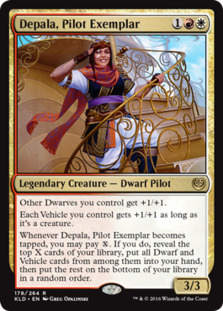
Depala, Pilot Exemplar is another card that's clearly designed for Commander, instantly becoming the general of choice for both Dwarf and Vehicle tribal. Unfortunately, legendary lords are really, really bad for constructed, since most tribal decks want to stack up as many lords and possible and being legendary works against this goal. That said, it seems unlikely that Dwarves would be tournament playable even with a lord on par with Master of the Pearl Trident. All in all, I wouldn't be surprised to see a lot of people cite Depala, Pilot Exemplar as one of their favorite cards from the set—she's super sweet—but I would be shocked if it had any financial relevance, at least over the short term.
Quick Finance Thoughts
-
Verdurous Gearhulk started off at $14.99 on SCG and doesn't seem to be selling much at all. While the card is good and offers more flexibility than most big green creature, $15 is insanely expensive for this card. There are currently 59 mythics in Standard (discounting Magic Origins and Dragons of Tarkir, which are about to rotate), and only six are worth $15 or more, which means that if this trend holds for Kaladesh, somewhere between 1.5 and 2 mythics will fall into this group. If you really think Verdurous Gearhulk will be one of the two most expensive mythics in the set, by all means buy it now, but this seems exceedingly unlikely to me.
-
Saheeli Rai started at $15.99 and is currently up to $19.99. As I mentioned before, I'm not sold on the new Izzet planeswalker, but apparently a lot of other people are. If you're in the "she's amazing" camp, $20 is a reasonable price over the short term. Liliana, the Last Hope went from $20 to $50 between her preview and Pro Tour Eldritch Moon. Personally, I'm waiting, but I can't shake the feeling that this is the next planeswalker I pass on during presales and end up regretting over the long run.
-
All of the energy cards and vehicles are starting off extremely cheap, with the mythics at $3.99 and the rares between $0.99 and $1.99. At this point, I don't think anyone really knows just how good these mechanics may end up. If you think either is going to be big in Standard, they could have room to grow.
Conclusion
Anyway, that's all for today! Make sure to keep checking back for more sweet Kaladesh previews over the next couple of weeks! So, what do you think? How many vehicles can you run in a normal deck before things get unreasonably clunky? Is Saheeli Rai better than I'm giving her credit for? What's your take on the energy mechanic? Do any of the other early spoilers excite you? Let me know in the comments, or you can reach me on Twitter @SaffronOlive or at SaffronOlive@MTGGoldfish.com.


